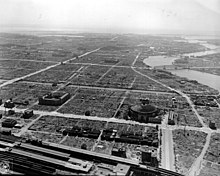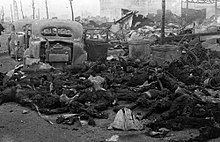
The Boeing B-29 Superfortress is an American four-engined propeller-driven heavy bomber, designed by Boeing and flown primarily by the United States during World War II and the Korean War. Named in allusion to its predecessor, the B-17 Flying Fortress, the Superfortress was designed for high-altitude strategic bombing, but also excelled in low-altitude night incendiary bombing, and in dropping naval mines to blockade Japan. B-29s dropped the atomic bombs on Hiroshima and Nagasaki, the only aircraft ever to drop nuclear weapons in combat.

Firebombing is a bombing technique designed to damage a target, generally an urban area, through the use of fire, caused by incendiary devices, rather than from the blast effect of large bombs. In popular usage, any act in which an incendiary device is used to initiate a fire is often described as a "firebombing".

A firestorm is a conflagration which attains such intensity that it creates and sustains its own wind system. It is most commonly a natural phenomenon, created during some of the largest bushfires and wildfires. Although the term has been used to describe certain large fires, the phenomenon's determining characteristic is a fire with its own storm-force winds from every point of the compass towards the storm's center, where the air is heated and then ascends.

The bombing of Kobe on March 16 and 17, 1945, was part of the strategic bombing air raids on Japan campaign waged by the United States against military and civilian targets and population centers during the Japan home islands campaign in the closing stages of the Pacific War. The city would be bombed again in later months.

The Twentieth Air Force (Air Forces Strategic) (20th AF) is a numbered air force of the United States Air Force Global Strike Command (AFGSC). It is headquartered at Francis E. Warren Air Force Base, Wyoming.

The bombing of Osaka during the Pacific War was part of the strategic bombing air raids on Japan campaign waged by the United States against military and civilian targets and population centers in Japan. It first took place from the middle of the night on March 13, 1945, to the early morning of the next day. There were also bomb raids on June 1, 6, 7, 15, 26, July 10, 24, and August 14, the last day of the war. It is said that more than 10,000 civilians died in these bombings.

The bombing of Nagoya by the United States Army Air Forces took place as part of the air raids on Japan during the closing months of the Pacific War in 1945.

During the Pacific War, Allied forces conducted air raids on Japan from 1942 to 1945, causing extensive destruction to the country's cities and killing between 241,000 and 900,000 people. During the first years of the Pacific War these attacks were limited to the Doolittle Raid in April 1942 and small-scale raids on military positions in the Kuril Islands from mid-1943. Strategic bombing raids began in June 1944 and continued until the end of the war in August 1945. Allied naval and land-based tactical air units also attacked Japan during 1945.

The 504th Bombardment Group was a World War II United States Army Air Forces combat organization.

The bombing of Kure took place by allied aircraft during air raids on Japan in the Pacific War in 1945. These raids targeted the major naval base located at the city, ships moored at this base or nearby, industrial facilities, and the city's urban area itself.

The XXI Bomber Command was a unit of the Twentieth Air Force in the Mariana Islands for strategic bombing during World War II.

The bombing of Hamamatsu was part of the strategic bombing campaign waged by the United States of America against military and civilian targets and population centers of the Empire of Japan during the Japan home islands campaign in the closing stages of the Pacific War in 1945.

The bombing of Shizuoka on June 19, 1945, was part of the strategic bombing campaign waged by the United States against military and civilian targets and population centers during the Japan home islands campaign in the closing stages of the Pacific War in 1945.

The bombing of Aomori on July 28, 1945, was part of the strategic bombing air raids on Japan waged by the United States against military and civilian targets and population centers during the Japan home islands campaign in the closing stages of the Pacific War.

The bombing of Yawata on the night of 15–16 June 1944 marked the beginning of the United States Army Air Forces (USAAF) strategic bombing campaign against the Japanese home islands during the Pacific War and was the first such raid to employ strategic bombers. The raid was undertaken by 75 Boeing B-29 Superfortress heavy bombers staging from bases in China. Only 47 of these aircraft dropped bombs near the raid's primary target, the Imperial Iron and Steel Works at Yawata in northern Kyūshū, and little damage was caused. Five B-29s were lost in accidents during the operation and two were destroyed by Japanese aircraft.
The bombing of Chiba was part of the strategic bombing air raids on Japan campaign waged by the United States of America against military and civilian targets and population centers during the Japan home islands campaign in the closing stages of the Pacific War, and included two separate air raids in 1945. The second, and larger, air raid of July 6, 1945 is also referred to as the “Tanabata Air Raid”, as it occurred on the night of a traditional festival.

The bombing of Kōfu was part of the air raids on Japan strategic bombing campaign waged by the United States against military and civilian targets and population centers of the Empire of Japan during the Japan home islands campaign in the closing stages of the Pacific War in 1945.

The bombing of Sendai on July 10, 1945, was part of the strategic bombing campaign waged by the United States against the civilian population and military targets during the Japan home islands campaign in the closing stages of the Pacific War in 1945.

The bombing of Okazaki was part of the strategic bombing air raids on Japan campaign waged by the United States against military and civilian targets and population centers during the Japan home islands campaign in the closing stages of the Pacific War.

On the night of 9/10 March 1945, the United States Army Air Forces (USAAF) conducted a devastating firebombing raid on Tokyo, the Japanese capital city. This attack was code-named Operation Meetinghouse by the USAAF and is known as the Tokyo Great Air Raid in Japan. Bombs dropped from 279 Boeing B-29 Superfortress heavy bombers burned out much of eastern Tokyo. More than 90,000 and possibly over 100,000 Japanese people were killed, mostly civilians, and one million were left homeless, making it the most destructive single air attack in human history. The Japanese air and civil defenses proved largely inadequate; 14 American aircraft and 96 airmen were lost.



























